Papers by Anthony Beavers

The “information age ” is often thought in terms of the digital revolution that begins with Turin... more The “information age ” is often thought in terms of the digital revolution that begins with Turing’s 1937 paper, “On computable numbers, with an application to the Entscheidungsproblem. ” However, this can only be partially correct. There are two aspects to Turing’s work: one dealing with questions of computation that leads to computer science and another concerned with building computing machines that leads to computer engineering. Here, we emphasize the latter because it shows us a Turing connected with mechanisms of information flow rather than solely with the mathematical and logical problems of computability for which he is better known. Our reasons for doing so will become clear in what follows. In fact, the 1937 paper just mentioned provides a general schematic for building a computing machine; this mechanical connection puts Turing on an historical continuum with others who discovered mechanisms to cope with information. Of those involved in this quest in the 19th Century, t...
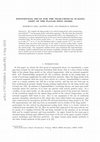
Essays in Philosophy, 2010
We consider the Ising model at its critical temperature with external magnetic field ha 15/8 on t... more We consider the Ising model at its critical temperature with external magnetic field ha 15/8 on the square lattice with lattice spacing a. We show that the truncated two-point function in this model decays exponentially with a rate independent of a. As a consequence, we show exponential decay in the near-critical scaling limit Euclidean magnetization field. For the lattice model with a = 1, the mass (inverse correlation length) is of order h 8/15 as h ↓ 0; for the Euclidean field, it equals exactly Ch 8/15 for some C. Although there has been much progress in the study of critical scaling limits, results on near-critical models are far fewer due to the lack of conformal invariance away from the critical point. Our arguments combine lattice and continuum FK representations, including coupled conformal loop and measure ensembles, showing that such ensembles can be useful even in the study of near-critical scaling limits. Thus we provide the first substantial application of measure ensembles.
Essays in Philosophy, 2010
A Computable Universe, 2012
In this paper, we employ the method of computational philosophy, the use of computational techniq... more In this paper, we employ the method of computational philosophy, the use of computational techniques to aid in the discovery of philosophical insights that might not be easily discovered otherwise, to show that it is not unreasonable to suggest 1) that there are genuine teleological causes in nature, 2) that such causes can be computed from Newtonian ("push") causation, provided that other architectural and environmental conditions are met, and 3) that it is possible to do so without recourse to semantics by taking an information-theoretic approach to measuring information flow in a system.
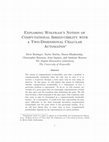
Emergence, Complexity and Computation, 2013
The notion of computational irreducibility says that a problem is computationally irreducible whe... more The notion of computational irreducibility says that a problem is computationally irreducible when the only way to solve it is to traverse a trajectory through a state space step by step using no shortcut. In this paper, we will explore this notion by addressing whether computational irreducibility is a consequence of how a particular problem is represented. To do so, we will examine two versions of a given game that are isomorphic representations of both the play space and the transition rules underlying the game. We will then develop a third isomorph of the play space with transition rules that seem to only be determined in a computationally irreducible manner. As a consequence, it would seem that representing the play space differently in the third isomorph introduces computational irreducibility into the game where it was previously lacking. If so, we will have shown that, in some cases at least, computational irreducibility depends on the representation of a given problem.

faculty.evansville.edu
In his famous 1950 paper where he presents what became the benchmark for success in artificial in... more In his famous 1950 paper where he presents what became the benchmark for success in artificial intelligence, Turing notes that "at the end of the century the use of words and general educated opinion will have altered so much that one will be able to speak of machines thinking without expecting to be contradicted" (Turing 1950, 442). Kurzweil (1990) suggests that Turing's prediction was correct, even if no machine has yet to pass the Turing Test. In the wake of the computer revolution, research in artificial intelligence and cognitive science has pushed in the direction of interpreting "thinking" as some sort of computational process. On this understanding, thinking is something computers (in principle) and humans (in practice) can both do. It is difficult to say precisely when in history the meaning of the term "thinking" headed in this direction. Signs are already present in the mechanistic and mathematical tendencies of the early Modern period, and maybe even glimmers are apparent in the ancient Greeks themselves. But over the long haul, we somehow now consider "thinking" as separate from the categories of "thoughtfulness" (in the general sense of wondering about things), "insight" and "wisdom." Intelligent machines are all around us, and the world is populated with smart cars, smart phones and even smart (robotic) appliances. But, though my cell phone might be smart, I do not take that to mean that it is thoughtful, insightful or wise. So, what has become of these latter categories? They seem to be bygones left behind by scientific and computational conceptions of thinking and knowledge that no longer have much use for them. In 2000, Allen, Varner and Zinser addressed the possibility of a Moral Turing Test (MTT) to judge the success of an automated moral agent (AMA), a theme that is repeated in Wallach and Allen (2009). While the authors are careful to note that a language-only test based on moral justifications, or reasons, would be inadequate, they consider a test based on moral behavior. "One way to shift the focus from reasons to actions," they write, "might be to restrict the information available to the human judge in some way. Suppose the human judge in the MTT is provided with descriptions of actual, morally significant actions of a human and an AMA, purged of all references that would identify the agents. If the judge correctly identifies the machine at a level above chance, then the machine has failed the test" (Wallach and Allen 2009, 206). While they are careful to note that indistinguishability between human and automated agents might set the bar for passing the test too low, such a test by its very nature decides the morality of an agent on the basis of appearances. Since there seems to be little else we could use to determine the success of an AMA, we may rightfully ask whether, analogous to the term "thinking" in other contexts, the term "moral" is headed for redescription here. Indeed, Wallach and Allen's survey of the problem space of machine ethics forces the question of whether in
Example: Lorem ipsum dolor sit amet, consectetuer adipiscing elit, sed diam nonummy nibh euismod ... more Example: Lorem ipsum dolor sit amet, consectetuer adipiscing elit, sed diam nonummy nibh euismod tincidunt ut laoreet dolore magna aliquam erat volutpat. Ut wisi enim ad minim veniam, quis nostrud exerci tation ullamcorper suscipit lobortis nisl ut aliquip ex ea commodo consequat.

Emotions and Affect in Human Factors and Human-Computer Interaction, 2017
Building simulated affects into artifacts poses a moral dilemma. On the one hand, in order for hu... more Building simulated affects into artifacts poses a moral dilemma. On the one hand, in order for humans to interact fully with machines, the machines need to meet them on human terms, and this requires machines that are capable of assessing human affective states and responding to them in kind. On the other hand, doing so amounts to a fundamental deception that humans will find it hard to keep in mind, namely that these machines do not actually have these affective states and may not, therefore, be worthy of our attachment and our moral regard. Yet, simulated affects, we argue, are necessary for creating machines that can make moral decisions, that affects are essential for disambiguating the utterances of machines and humans, and that not all forms of deception are bad. After an initial provocation, these arguments are taken up in order, after which we argue further that while simulated affects are necessary, they could nonetheless lead to abuse. Therefore, the standard ethical limits and principles involved with any technological innovation must be respected.

There once was a philosopher not to be named FF, who betrayed his teacher and in so doing made a ... more There once was a philosopher not to be named FF, who betrayed his teacher and in so doing made a mess of “the profession.” This master remarked that no great philosopher was wrong, but that each reported on how we stood in relation to being during his historical epoch. While naming him may lead to immediate dismissal, he nonetheless stirred the pot and in so doing tried to revitalize a profession that was languishing in his midst. This man was no relativist, but one who sought only to make philosophy relevant again. For what could make the history of philosophy more relevant than to read it as a record of human transformation rather than a competition to find the one truth that could stand still for all time? That man was part poet, part philosopher, part provocateur; and with that insight, he managed to uncover more than most previous philosophers covered over in a lifetime. Those who know him already know of whom I speak; those who don‟t will already be harboring suspicions.
Page 1. Typicality Effects and Resilience in Evolving Dynamic Associative Networks Anthony F. Bea... more Page 1. Typicality Effects and Resilience in Evolving Dynamic Associative Networks Anthony F. Beavers The University of Evansville 1800 Lincoln Avenue Evansville, Indiana 47722 afbeavers@gmail.com Abstract This paper ...
The paper explores the relevance and pertinence of Luciano Floridi’s Pihilosophy of Information, ... more The paper explores the relevance and pertinence of Luciano Floridi’s Pihilosophy of Information, which is considered in the light of Western scientific revolutions and the establishment of brand new paradigms, both in Sciences and Philosophy. An analogy with the “Mathematical Turn” of Modernity allows establishing the revolutionary reach of Floridi’s work, which acceptance would involve overcoming the epistemological obstacle of scholasticism, aiming for the historical dynamism inherent in scientific progress.
The Biographical Encyclopedia of Astronomers, 2007
The Biographical Encyclopedia of Astronomers, 2007
Biographical Encyclopedia of Astronomers, 2014
Philosophical Psychology, 2013
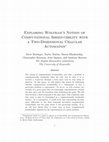
faculty.evansville.edu
The notion of computational irreducibility says that a problem is computationally irreducible whe... more The notion of computational irreducibility says that a problem is computationally irreducible when the only way to solve it is to traverse a trajectory through a state space step by step using no shortcut. In this paper, we will explore this notion by addressing whether computational irreducibility is a consequence of how a particular problem is represented. To do so, we will examine two versions of a given game that are isomorphic representations of both the play space and the transition rules underlying the game. We will then develop a third isomorph of the play space with transition rules that seem to only be determined in a computationally irreducible manner. As a consequence, it would seem that representing the play space di↵erently in the third isomorph introduces computational irreducibility into the game where it was previously lacking. If so, we will have shown that, in some cases at least, computational irreducibility depends on the representation of a given problem.
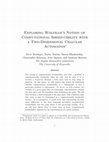
faculty.evansville.edu
The notion of computational irreducibility says that a problem is computationally irreducible whe... more The notion of computational irreducibility says that a problem is computationally irreducible when the only way to solve it is to traverse a trajectory through a state space step by step using no shortcut. In this paper, we will explore this notion by addressing whether computational irreducibility is a consequence of how a particular problem is represented. To do so, we will examine two versions of a given game that are isomorphic representations of both the play space and the transition rules underlying the game. We will then develop a third isomorph of the play space with transition rules that seem to only be determined in a computationally irreducible manner. As a consequence, it would seem that representing the play space di↵erently in the third isomorph introduces computational irreducibility into the game where it was previously lacking. If so, we will have shown that, in some cases at least, computational irreducibility depends on the representation of a given problem.
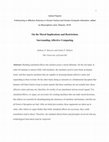
Building simulated affects into artifacts poses a moral dilemma. On the one hand, in order for hu... more Building simulated affects into artifacts poses a moral dilemma. On the one hand, in order for humans to interact fully with machines, the machines need to meet them on human terms, and this requires machines that are capable of assessing human affective states and responding to them in kind. On the other hand, doing so amounts to a fundamental deception that humans will find it hard to keep in mind, namely that these machines do not actually have these affective states and may not, therefore, be worthy of our attachment and our moral regard. Yet, simulated affects, we argue, are necessary for creating machines that can make moral decisions, that affects are essential for disambiguating the utterances of machines and humans, and that not all forms of deception are bad. After an initial provocation, these arguments are taken up in order, after which we argue further that while simulated affects are necessary, they could nonetheless lead to abuse. Therefore, the standard ethical limits and principles involved with any technological innovation must be respected.

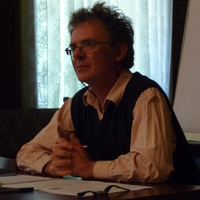









Uploads
Papers by Anthony Beavers